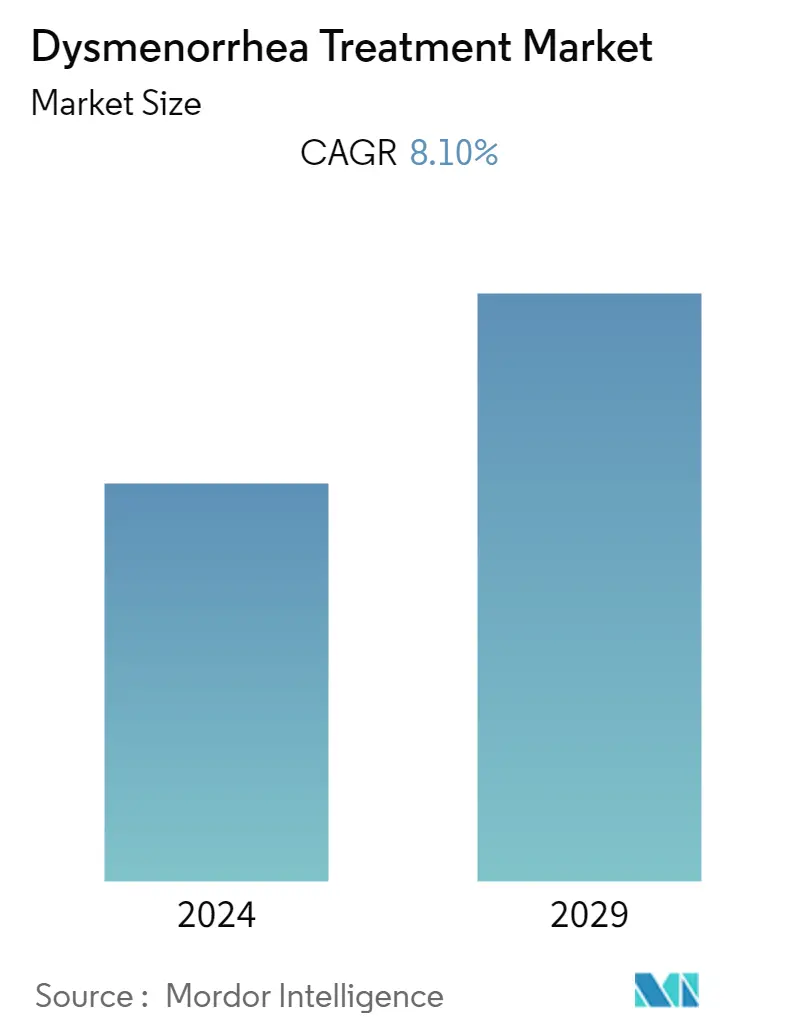Market Size of Dysmenorrhea Treatment Industry

| Study Period | 2021 - 2029 |
| Base Year For Estimation | 2023 |
| Forecast Data Period | 2024 - 2029 |
| CAGR | 8.10 % |
| Fastest Growing Market | Asia Pacific |
| Largest Market | North America |
Major Players
*Disclaimer: Major Players sorted in no particular order |
Need a report that reflects how COVID-19 has impacted this market and its growth?
Dysmenorrhea Treatment Market Analysis
The dysmenorrhea treatment market is expected to register a CAGR of 8.1% during the forecast period.
COVID-19 was an unprecedented health concern affecting millions physically and mentally. The pandemic significantly impacted many people's mental health, resulting in loneliness, social isolation, financial strain, anxiety and fear of contracting the virus, and uncertainty for the future. It has been proven that periods of stress and psychological distress can affect a woman's menstrual health. Stressors can activate the hypothalamic-pituitary-gonadal (HPG) axis and alter the neuro-modulatory cascade that drives gonadotropin, releasing hormone (GnRH) regulation, which results in an irregular menstrual cycle. The changes in menstrual cycles lead to higher episodes of dysmenorrhea, significantly impacting the market.
According to a study published in March 2021 by Frontiers in Endocrinology, 46% of women reported a change in their menstrual cycle, with 30% of new dysmenorrhea cases since the pandemic began. Thus, COVID-19 had an impact on the dysmenorrhea treatment market significantly. Even after the pandemic, the market is expected to see a surge over the forecast period with increasing cases of dysmenorrhea and rising research and development.
Dysmenorrhea is commonly known as menstrual cramps, which affects women. The key factors attributed to driving the market growth are the increasing prevalence of dysmenorrhea among adolescent girls and rising cases of menstrual cramps due to genetic disorders. As per the study published in March 2022 by BMC Women's Health, the observed dysmenorrhea in the study; 1107 (92.3%) women had non-pathological dysmenorrhea (primary) while 92 (7.7%) women had pathological dysmenorrhea (secondary) respectively. Moreover, as per a study published in February 2021 by BMJ Open, dysmenorrhea was a common health problem among graduating university students. The prevalence of dysmenorrhea was 317 (51.5%) in Ethiopia. The educational status of the father, chocolate consumption (95%), daily breakfast intake (less than 5 days/week), irregular menstrual cycle, and positive family history of dysmenorrhea, had a statistically significant association with dysmenorrhea. Thus, the increasing burden of dysmenorrhea is expected to boost the growth of the market over the forecast period.
Moreover, increasing research and development for developing innovative drugs is expected to boost the growth of the market. As per a study published in July 2021 by the Journal of Clinical Medicine, various combinations of non-steroidal anti-inflammatory drugs (NSAIDs) and spasmolytics have been developed and tested, demonstrating a huge potential for future research to develop modern, effective combinations and search for new indications for the existing fixed-dose combination drugs for treating dysmenorrhea. Thus, research studies highlighting the potential of existing treatments for menstrual cramps and developing new drugs may drive the market.
However, side effects and complications associated with long-term treatment and lack of awareness about reproductive health in women are expected to restrain the market's growth during the forecast period.
